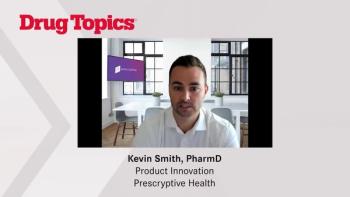
- Drug Topics February 2022
- Volume 166
- Issue 02
Lean Methodology and Technology Can Support Clinical Services
Rethinking how technology can simplify routine tasks can help pharmacists and pharmacy technicians streamline their days.
Joe Maki, PharmD, vice president of pharmacy at Novant Health in Winston-Salem, North Carolina, wanted to figure out why it was taking so long for pharmacy technicians to refill the medication cabinets in one of the health system’s emergency departments. After deploying Lean operations methodology and machine learning software, his team discovered that the busiest time in the emergency department was between 6 and 8 am.
During those early morning hours, pharmacy technicians were slowed by the steady flow of patient and staff foot traffic. Every time a nurse walked up to retrieve a medication from the cabinet, the technician had to step aside. As a result of the work by Maki’s team, pharmacy technicians now refill the medicine cabinets toward the end of the second shift—usually around midnight.
“We [now] have really efficient workflows in the pharmacy department,” Maki said. “That means that we’re touching the cabinets at the right time of the day.”
According to Purdue University, Lean tools are used to eliminate processes that don’t add value. Lean tools are often used along with the Six Sigma methodology, which attempts to reduce variation within a process. When Lean tools are used in concert with the Six Sigma methodology, they can reduce and manage various types of waste in organizations.1
Technology Supports Pharmacists Practicing “At the Top of Their License”
According to Anita Jacobson, PharmD, clinical professor at the University of Rhode Island College of Pharmacy in Kingston, the goal of most pharmacy technology platforms is “to reduce the human touch aspect at different points in dispensing…and to increase patient safety.”
Pharmacists with a PharmD degree have 6 years of education in addition to experiential learning in a clinical setting, said Jacobson, who is also a pharmacist at Eleanor Slater Hospital in Cranston, Rhode Island. Her point: Technology can help pharmacists use their years of training, which includes “look[ing] for and prevent[ing] medication-related problems and for untreated or overtreated indications and [adverse] effects.”
Making routine tasks faster for pharmacists, pharmacy technicians, and clinicians is one reason Novant Health uses Lean methodology, machine learning, and other software solutions, said Maki. One of his priorities is to increase the amount of time nurses can spend at the patient bedside. But they can’t do that if they’re spending as much as 20% of their day at the nursing unit’s medicine cabinet, he said.
Results of a 2018 study showed that half of health system pharmacists self-identified as being at risk for burnout.2 Using Lean methodology and technology to support pharmacy teams and clinicians throughout the health care system is in alignment with Maki’s mission to “remove ‘bottom of license’” tasks that overburden staff.
“Look at the [typical] hospital pharmacist who spends a lot of time tracking down information in the medical record,” Maki said, “[or at] the time they’re using Excel and other manual ways to calculate the best use of drugs. They’re [working with] techs to track down a patient’s history.”
He doesn’t want Novant Health’s pharmacists spending time pulling up a patient’s lab values from the electronic health record (EHR) or another platform to calculate the right medication dose. Instead, he prefers that pharmacists rely on software that serves up that information with little human intervention.
Community pharmacies can also use automation to improve efficiency, Jacobson said. For example, automation can be used to keep track of the top 100 or 500 drugs and dispense them in the typical quantities of 30 or 90 days, she said.
Jacobson also pointed to technology platforms that allow a pharmacist to verify a photograph or barcode of a medication from a remote location. Using these tools allows community pharmacies to increase the capacity of their pharmacists.
A Healthy Mix of Caution and Optimism
Still, Jacobson cautioned pharmacy leaders to be mindful when deploying technology. While the potential upside is that pharmacists have more time to counsel patients, the downside may be a dramatic increase in the number of prescriptions per day. At first blush, increasing the number of prescriptions dispensed in a day sounds like a good thing—but patient safety may be negatively impacted.
While connectivity between the EHR and pharmacy systems is generally considered positive, Jacobson also cautioned that without intervention, proactive communication, and education by a pharmacist or physician, it falls on the patient to understand the medications that they should be taking—a challenge when a new medication is prescribed, especially when that medication replaces a previous prescription, she said.
Refills are automatically generated for patients, who arrive to pick them up at the pharmacy, Jacobson explained. While automated refills are convenient and can help with medication adherence, prescriptions may be getting pushed out to patients who are taking as many as 15 medications each day. A new medication may only add to their confusion.
Jacobson cited an example of an older patient taking blood pressure medication. Because the previous medication was causing the patient’s heart rate to slow down too much, her physician prescribed a new one. If the physician or a pharmacist doesn’t take the time to educate the patient about the reason associated with the medication change, she may continue to take both medications.
Taking the scenario further, that same patient could fall because of her slow heart rate, breaking her hip or dying as a result, Jacobson explained. Access to the physician’s EHR can help, she added, because it gives the pharmacist access to the patient’s care plan and lab values.
An even better solution, said Jacobson, requires a technology that dates to 1876, the year that Alexander Graham Bell secured a patent for inventing the telephone.3 The solution? A simple phone call where the patient’s physician discusses the updated care plan with the pharmacist.
The Future of Pharmacy Technology
Mark Sullivan, PharmD, BCPS, associate chief pharmacy officer for Vanderbilt University Hospital and Clinics in Nashville, Tennessee, looks toward future technology possibilities within the pharmacy department. He pictures, for example, the “autonomous hospital” where targeted therapies will be used to treat bone cancer, which is typically very painful for patients. “Getting the pain medications based on an evidence-based algorithm that’s physician-approved” can have a significant impact on the patient’s experience in the hospital, he said.
These autonomous hospitals put the patient in the driver’s seat, allowing them to use a tablet to communicate their pain score. From there, the appropriate medication and dose can be selected from the medication cabinet, confirmed by a clinician, and given to the patient to address their pain, Sullivan explained. “The nurse doesn’t have to do a [pain] assessment. The patient helps with that.”
Does your pharmacy use technology tools to support clinical service offerings? Share your stories: email lbiscaldi@mjhlifesciences.com.
References
- Lean tools and principles and their applications. Purdue University. June 30, 2021. Accessed January 10, 2022. https://www.purdue.edu/leansixsigmaonline/blog/lean-tools/
- Durham ME, Bush PW, Ball AM. Evidence of burnout in health-system pharmacists. Am J Health Syst Pharm. 2018;75(23)(suppl 4):S93-S100. doi:10.2146/ajhp170818
- Who is credited with inventing the telephone? Library of Congress. November 19, 2019. Accessed January 10, 2022. https://www.loc.gov/everyday-mysteries/item/who-is-credited-with-inventing-the-telephone/
Articles in this issue
almost 4 years ago
Navigating Health Care as a Transgender Patientalmost 4 years ago
Paxlovid: Oral Antiviral for the Treatment of COVID-19almost 4 years ago
Tips for Managing Autoimmune Disease During Pregnancyalmost 4 years ago
Practice Update: Treating Patients Hospitalized With COVID-19almost 4 years ago
Retail Pharmacy Has Reached the Breaking Pointalmost 4 years ago
Managing Migraine: From Acute Treatment to CGRPsalmost 4 years ago
Review: Vaccine Guidelines for Older Adultsalmost 4 years ago
OTC Update: Asthma Medicationsalmost 4 years ago
Become A Champion for Heart HealthNewsletter
Pharmacy practice is always changing. Stay ahead of the curve with the Drug Topics newsletter and get the latest drug information, industry trends, and patient care tips.















































































































